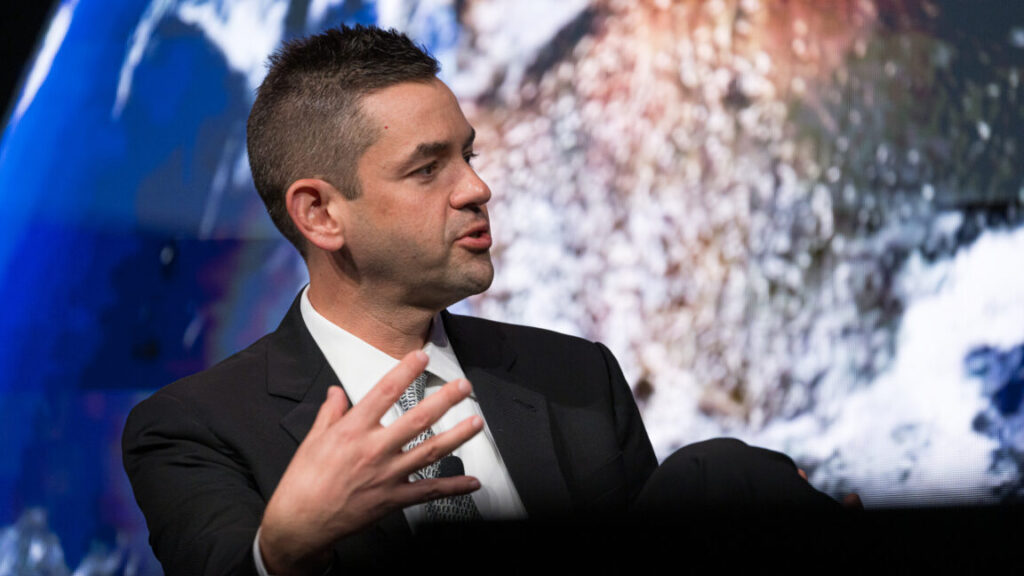
Meanwhile, over about the same time period, NASA’s Space Launch System rocket, Orion deep space crew capsule, and ground support system upgrades cost nearly $50 billion before the unpiloted Artemis I mission in 2022, according to an analysis by the Planetary Society. That sum has now risen to just shy of $60 billion.
The core stage for NASA’s second Space Launch System rocket, set to fly on the Artemis II mission, was raised vertical and placed on a support fixture this week inside the Vehicle Assembly Building at Kennedy Space Center, Florida.
Credit:
NASA
Artemis II, the next flight in NASA’s Artemis program, is scheduled for launch with an SLS rocket and Orion spacecraft in 2026 to carry a crew of four astronauts around the far side of the Moon and back to Earth. Artemis III, as NASA currently envisions it, will launch no sooner than mid-2027 on another SLS and Orion, which will dock with SpaceX’s Starship lander near the Moon for the final descent to the lunar south pole.
No parts of the SLS rocket are reusable, and last year, NASA’s inspector general estimated the next three Artemis crew launches will each cost $4.2 billion—more than the agency’s total spending to help SpaceX fund the development of the Crew Dragon spacecraft.
“We’re about to enter an era of great experimentation,” Isaacman said Wednesday.
Listening to the broader context of Isaacman’s comments Wednesday, he may have meant this in not just a technical sense, but in the way NASA does business. The incoming Trump administration will certainly keep NASA’s goal of landing people on the Moon, but the agency’s new leaders are widely expected to assess how to achieve this goal without the budgetary burden of the SLS rocket. One solution might be to piece together elements from different rocket companies, like SpaceX, Blue Origin, and United Launch Alliance, to replicate the capabilities of the Space Launch System.
“We have the best spaceship in the world right now in Dragon,” Isaacman said. “This is what American astronauts go to the space station in routinely, every six months or so. But we’re about to have this light switch-like moment when Starship comes online.”
SpaceX has launched six full-scale test flights of the Starship rocket, and the next one is scheduled for January. SpaceX demonstrated the first catch of the rocket’s enormous Super Heavy booster after a launch in October. Next year, SpaceX aims to catch the Starship upper stage after coming back from low-Earth orbit and kick off in-space refueling trials with two ships docked together.
NASA will human-rate Starship for landings on the Moon, and SpaceX eventually plans to launch and land people on Earth using Starship. Once operational, Starship will be able to deliver payloads between 100 and 150 metric tons to low-Earth orbit, and with the advent of orbital refueling, will carry the same payload mass to the Moon, Mars, or other destinations.
“What happens when industry starts cranking out spaceships out of multiple factories? SpaceX has a great vision for this, but so does Blue Origin. You’ve got Rocket Lab building a brand-new behemoth rocket,” Isaacman said. “You’re going to have lots and lots of people in space at one time, and that’s why I call it a light switch-like moment, where a lot of things are going to change.”
NASA’s spending levels peaked relative to the entire federal budget in 1966, when funding for the space program accounted for 4.4 percent of all government spending. In the last few years, this has fallen to about 0.5 percent.
“We can do some pretty awesome things when you can write that big of a check,” Isaacman said. “We can go to the Moon. We can bring people back safely. That’s pretty awesome, but we’re going into a new era now where some of this funding can come privately, through commercial endeavors, but still for the benefit of everyone.”